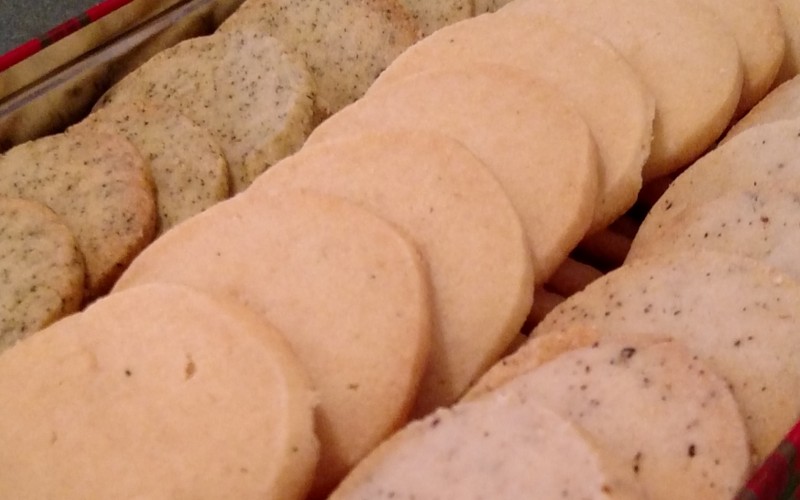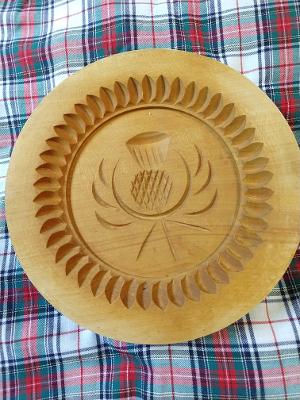Carolyn McDonald Graf

Shortbread is perhaps the best known of Scotland’s traditional foods. Its roots go far back and there are many, many, stories and myths associated with it. Even the name has confusing origins. Biscuit, meaning twice baked, was, and still is, the name used for small crispy baked goods in Scotland. Bakers called it “bread” to avoid paying a tax levied on biscuits. It is also unclear what the “short” means. According to the Oxford English Dictionary, “Short” (definition 20): Of edible substances: Friable, easily crumbled. This describes the process of making shortbread. This could also be where the English term “shortening” comes from as the butter coats the flour and keeps the baked goods crumbly. According to John Ayto, the term “shortbread” dates back only as far as the early nineteenth century. [An A-Z of Food and Drink, Oxford University Press: Oxford 2002 (p. 310).] What was it called prior to this? Perhaps just biscuits.
Although the name may be somewhat modern, the recipe dates much further back. One of the common shapes is round with fluted edges made by pinching the edges of the circle. One story is that this represented the sun and was part of the ancient pagan midwinter celebration, a Yule Cake. Shortbread later became an important part of Christmas and New Year celebrations. Mary Queen of Scots is credited with popularizing a form of shortbread called Petticoat Tails, thin round biscuits cut into triangles. Some say the name came from the French petites gatelles which means little cakes. Others say it came from the reign of Queen Elizabeth the First, where the shape of the shortbread resembled the pattern pieces of a ladies petticoat. The word for pattern was tally and thus the name “petticoat tallis.” Today, shortbread is traditionally formed into one of three shapes: one large circle divided into segments (“Petticoat Tails”); individual round biscuits (“Shortbread Rounds”); or a thick rectangular slab cut into “fingers.” All are pricked with holes to allow the dough to cook evenly and crisply.
Its simple ingredients: flour, sugar, and butter, were common to many cultures and it is interesting how each culture took these ingredients and created a unique product. The earliest Scottish shortbreads surely had ground oats in the mixture. Originally butter was considered food of the poorer classes. The wealthier upper classes used cream to enrich their baking. With the rise of the middle class in the 12th century, butter became more common and written recipes using it became more prevalent. Early shortbread recipes included caraway seeds or decorations of candied fruit and nuts. Even though butter was common, sugar was not, so shortbread was part of special celebrations. In Shetland a decorated shortbread was traditionally broken over a bride’s head before she entered her new home.
There are countless shortbread recipes. Many include decorations and flavorings. There are molds to make then in fantastic shapes and designs. Here are two recipes for basic shortbread, one from the 19th century and one modern. They are very similar. Many modern recipes call for rice flour to make an even crumblier texture.
[19th century]
Short Bread, Scotch. Mix two pounds of flour with four ounces of moist sugar, two ounces of candied citron, chopped small, and two ounces of sweet almonds, blanched and sliced. Rub one pound of butter into the flour, melt another half pound of butter, and with this work up the four to a smooth paste. If a plainer cake is wanted, less butter may be used. Sometimes the whole of the butter is melted, and then the bread is more easily made. Roll out the pastry to the thickness of an inch, and in a large oval shape, pinch the edges evenly, prick the surface with a fork or skewer, and sprinkle large comfits over the top. Cut the oval across, thus making two cakes, and place these upon paper rubbed with flour, and then upon tins. Bake in a moderate oven. When the bread is lightly browned, it is done enough. It should be remembered that the less the bread is kneaded the shorter it will be.
Source: Cassell’s Dictionary of Cookery with Numerous Illustrations [Cassell, Petter, Galpin & Co.:London] 1874? (p. 866)
[20th century]
Shortbread
The ingredients should be warm and dry
- 1 lb (450 g.) butter
- 8 oz (225 g.) castor sugar (granulated sugar can be used)
- pinch of salt
- 1 lb (450 g.) sifted flour
- 8 oz (225 g.) rice flour
Cream the butter and sugar together very well. Mix the flours and salt, sift them, then incorporate them gradually but thoroughly until the dough is like a shortcrust pastry texture. Do not knead or roll out as this only toughens it. Press with the hand into 2 round cakes, then put on to an ungreased baking sheet covered with baking-paper. The usual thickness is about 3/4 inch (1.9 cm.) for an 8-inch (20.3 cm.) shortbread. Pinch the edges regularly with the finger and thumb and prick all over, lightly with fork. Cook in a pre-heated oven at 375 degrees F. (190 degrees C.) or gas mark 5 for about 1 hour, and after 20 minutes reduce the heat to 350 degrees F. (180 degrees C.) or gas mark 4 to let it crisp up and get a pale fawn colour. Leave to cool before putting on to a rack. NOTE: if rice flour is not available then all wheat flour can be used, but reduce to 1 lb. (450 g. ) in all.”
Source: Traditional Scottish Cookery, Theodora FitzGibbon [Fontana Paperbacks:UK] 1980 (p. 252)
Shortbread can also be baked in a mold. See the following article.
Shortbread Molds
Molds for forming breads date from 3000 BC in Mesopotamia, Egypt and Greece. Pottery, wood carving and metal casting in the Bronze Age gave rise to the making of molds for decorative purposes. There is evidence of what we would call cookies found in the Indus Valley from 2500B.C.

The Romans used clay plaques to press images on medications, wax, clay, and honey cakes. The stiff honey cake dough was molded into complex forms for the church and for royalty. It is said that Germans made cakes imprinted with pictures for the winter solstice as a sacrifice to Wotan, King of Nordic gods. The Romans brought the tradition of molded cakes and bread with them to England where it was adopted by Pagans and later the Christian monasteries. Religious motifs were the predominant designs.
In central Europe during the 15th and 16th centuries, each area had its own recipe for honey bread and added various amounts of spices to create what we might know as gingerbread. Gingerbread bakers had their own guild by 1415. There were many artists at this time capable of making the detailed wooden molds used by the bakers and these artisans were hired by royalty to create molds for their own political propaganda. One attempt was made by Emperor Frederick III in 1487 when he had 4000 gingerbread cookies imprinted with his image and gave them to the children in his villages.
At this time, designs were thought to have special powers and eating a specific design could change ones fortune. Thus a dog represented fidelity, pigs: luck, a hare: fertility, a lionman: virility and a heart: love.

In the 18th century, picture cakes reached a larger audience with images that reflected the lives of the common people. Some were used as announcements of birth or marriage, local news and, of course, love. Religious motifs continued as well. The need to bake more cookies for a larger audience gave way to methods of mass production. The introduction of tin cutters and metal molds with many individual pictures pressed at one time eroded the artistic quality of the molds. These molds stressed symmetry and ornamentation. The art of carving wooden molds declined and the old molds became valuable antiques.
When considering the origin of molds for Scottish shortbread, there may be theories, but often not much definite information. There are references to gingerbread being pressed into molds in Scottish recipes as far back as 1710 (Broths to Bannocks, Catherine Brown, John Murray Publishers, London, 1990 p.196) and it is reasonable to assume that shortbread may have been used in this way. But, most of the old shortbread recipes give directions for making shortbread into rounds, petticoat tails or “fingers”. Although modern molds for shortbread abound, including wood, metal, clay, and ceramic, it is difficult to determine when this became popular. The most ubiquitous molds found at Highland games are from Brown Bag Cookie Company, which began making ceramic cookie molds in 1982. Obviously more research is needed. Learn more about the history of shortbread molds at http://www.cookiemold.com/cookiemolds-history.html.
How to Bake Shortbread in a Ceramic Mold
To bake your shortbread in a ceramic mold, lightly grease the mold and preheat your oven to 325° F. Press the dough firmly into the mold to remove air pockets. Prick surface with a fork and bake 30 to 35 minutes until lightly browned. Run a knife around the edges and let cool for 10 minutes. Run a knife around the edges again and turn shortbread out onto a cutting board. You may have to tap it firmly to release the shortbread. Cut into sections while still warm.

